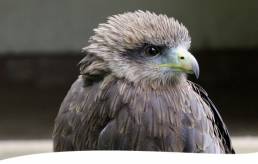Kites
Kites can be characterised as having a forked tail, smaller beak and feebler talons than other birds of prey, such as buzzards and hawks.
Their long wingspan makes them look much bigger in flight than they actually are. They are opportunistic hunters and will take a large variety of prey. Kites are also known for scavenging on carrion and around rubbish tips. Thanks to Gauntlet’s brilliant Kites the 3.00pm flying display is one of the most talked about birds of prey demonstrations in the UK. The Kite team consists of a mixture of Red and Black Kites, there are also a few cheekier ones, who often like to steal the presenter’s hat and glasses during demonstrations!

Red Kite
In 1999 the Red Kite was voted ‘bird of the century’ by the British Trust for Ornithology.
LATIN NAME: Milvus milvus
DISTRIBUTION: Europe, parts of Asia, North West Africa
HABITAT: Wide ranging over open or lightly wooded country, with open access to large trees
DIET: Extremely varied – birds, mammals, reptiles, fish, amphibians, invertebrates and carrion
WINGSPAN: 145–165cm

Black Kite
Black Kites are regularly seen scavenging alongside Vultures and other animals. They fight over the smaller scraps of carcass or pick over the leftovers.
LATIN NAME: Milvus migrans
DISTRIBUTION: Europe, Africa, Middle East, India and Southern Asia, Australia
HABITAT: Wide ranging in all types of open or lightly wooded country, grasslands, wetlands, coasts – frequently found around towns and cities
DIET: Extremely varied and opportunistic – from insects caught in flight to small mammals, birds and reptiles, common around areas of human activity like rubbish tips
WINGSPAN: 145–165cm

Brahminy Kite
Brahminy Kite eat dead fish, seafood and occasionally live prey like bats.
LATIN NAME: Haliastur indus
DISTRIBUTION: South Asia, Northern Australia
HABITAT: Coasts, wetlands, forest and lowlands
DIET: Mainly scavenges dead fish, will also hunt live prey
WINGSPAN: 110–125cm

Yellow-billed Kite
As it’s name suggests – the Yellow-billed Kite is easily recognized by its entirely yellow bill.
LATIN NAME: Milvus aegyptius
DISTRIBUTION: Sub-Saharan Africa
HABITAT: They are found in almost all habitats, including parks in suburbia, but rare in the arid coastal and semi-desert areas
DIET: They feed on a wide range of small vertebrates and insects – most of which is scavenged
WINGSPAN: 160–180cm

